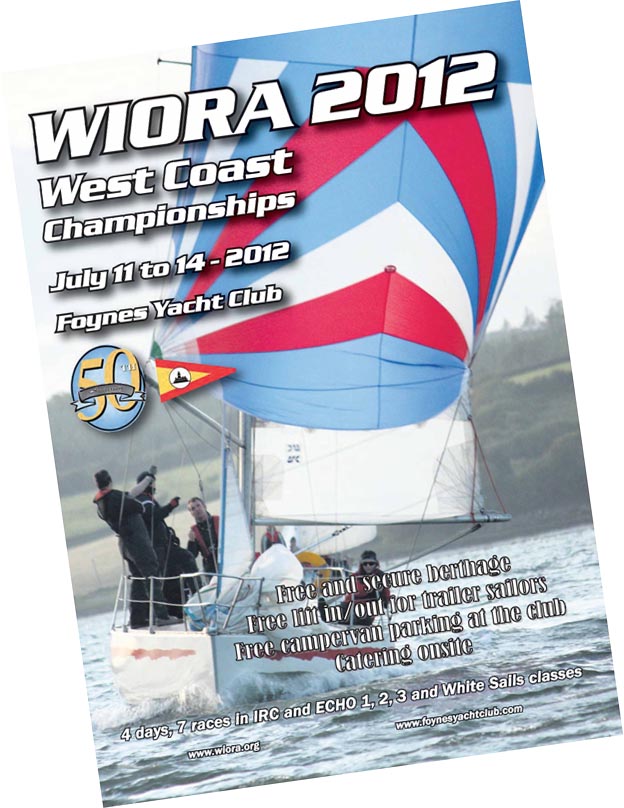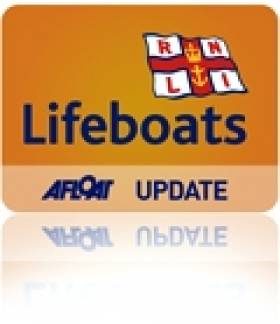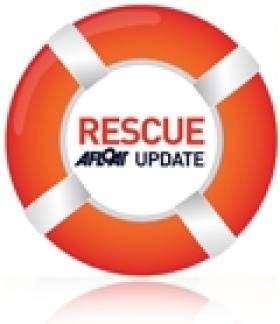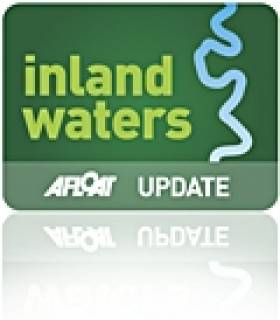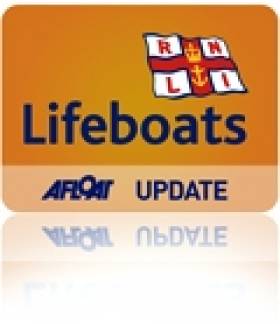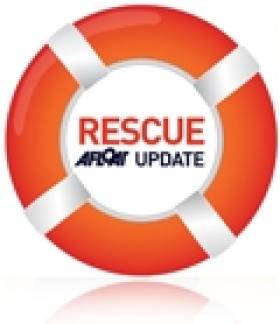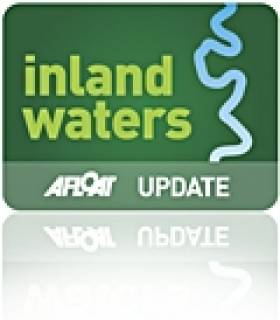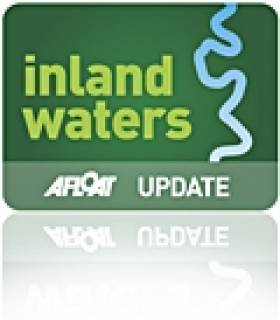Displaying items by tag: Lough Derg
Lough Derg RNLI Lifeboat was launched to assist 3 persons aboard a 32ft cruiser that had an engine overheating problem.
#rnl i– Lough Derg RNLI lifeboat was requested by Valentia Coast Guard to assist 3 persons on board a 32ft crusier that was in danger of grounding on the Goat Road, south of Bellevue Point, after its engine had dangerously overheated. The skipper of the cruiser switched off his engine to prevent an engine fire. At 14.08hrs, the lifeboat launched with Helm Colin Knight, Eleanor Hooker and Tom Dunne on board. Winds were northerly, Force 4, and visibility was good.
The skipper of a passing barge, Knocknagow, advised the cruiser to drop anchor to prevent themselves being grounded on the Goat Road and raised the alarm. (The Goat Road is a rocky outcrop for migrating Terns. It is marked by the navigation mark E.
The cruiser passed a tow line to the barge, who took it under an alongside tow. When the lifeobat arrived on scene, they found all safe and well. An RNLI crew member was transferred to the cruiser, who passed the tow to the lifeboat. The cruiser was towed to Williamstown Harbour.
Lifeboat Helm, Colin Knight praised the skipper of cruiser for his swift action in cutting their engine saying that 'had he not noticed and been attentive to the overheating indicator, they would have been a definite risk of an engine fire on board'.
The lifeboat returned to station and was ready for service again at 15.15
Weekend Rescues at Lough Derg and Doolin
#RESCUE - Six people were rescued from a cruiser that ran aground in high winds on Lough Derg at the weekend.
The Irish Times reports that the group had been wakeboarding near Youghal Bay on Saturday afternoon when the 37ft boat's propeller fouled on the tow rope.
The crew attempted to free the propeller but the boat began drifting to the rocks in Force 7 gusts.
The Irish Coast Guard were quickly notified and put out a message for assistance to all vessels in the area while Lough Derg RNLI lifeboat responded to the scene, finding the cruiser on the rocks but not seriously damaged.
The boat was subsequently towed to Dromineer Bay. No injuries were reported.
Elsewhere, the Irish Coast Guard was called to assist a man who had been camping on an island bird sanctuary off Co Clare.
According to the Clare Herald, the harbourmaster at Doolin noticed the man camped on Crab Island, some 400 metres from the mainland, amid "extreme" sea conditions.
One of Ireland's worst drowning tragedies occurred in the same area in July 1983, when eight young men - including three brothers - drowned while swimming at Trá Leathan.
It's believed that the man made his way by kayak on Friday evening to the island - designated as a protected area due to the presence of a particular seabird species.
The Doolin coastguard unit made three trips to the island to retrieve the man and his belongings.
#INLANDWATERWAYS – Members of the public and community and tourism groups throughout counties Clare, Galway and Tipperary are being invited to have their say on the future provision of signage in the Lough Derg area.
A signage audit has been carried out by consultants URS Ireland, and a presentation will be made on the initial findings of the consultants at two public meetings to be held on Wednesday, 30th May in Portumna and Killaloe.
The Signage Strategy for the Lough Derg area is being spearheaded by the Lough Derg Marketing Strategy Group (LDMSG), which last year produced a Destination Development Action Plan for the region. Earlier this year, the Mid West Regional Authority (MWRA), which is a member organisation of the Group, appointed URS Ireland to prepare the Signage Strategy.
Mr. Joe MacGrath, LDMSG Chairperson and Manager of North Tipperary County Council, explained that the purpose of the upcoming public meetings would be "to ensure that the Signage Strategy being developed provides maximum benefits to the Lough Derg Area".
Mr. MacGrath added: "All are welcome to attend either of the meetings and to have their say on the future approach to signage provision in the Lough Derg area. The meeting should be of interest to tourism and leisure businesses, accommodation providers, local community and heritage groups, walkers, cyclists, lake users, residents and anyone concerned with the improvement of signage in the Lough Derg Area."
Liam Conneally, Secretary of the LDMSG indicated that the participation of members of the public in the development of the Strategy "is vitally important to the Strategy's overall success".
Mr. Conneally "The audit carried out by URS focuses on the need for and benefits of tourism signage, including orientation, interpretive and information boards, in the Lough Derg area. It also points to the importance of there being public participation in the formulation of any future Signage Strategy."
"The provision of appropriate signage throughout the region will not only serve to benefit visitors to the area, but also will also create significant benefits for tourism and hospitality sector operators," he concluded.
The LDMSG was established to bring a coherent marketing focus to the Lough Derg Catchment area and to establish the Lough Derg Brand nationally and internationally. The Group involves a broad range of representation from stakeholders, including local authorities from Clare, Galway, and North Tipperary, the Mid-West Regional Authority (Secretariat to the group), Shannon Development, Waterways Ireland, Fáilte Ireland, and business representatives from the Lough Derg area.
The Signage Strategy meetings will be held on Wednesday, May 30th at Portumna Town and Community Hall from 5.00pm to 6.30pm and at the Lakeside Hotel, Killaloe from 8.00pm to 9.30pm.
Lifeboat Launches For Missing Person on Lough Derg
#RNLI – Lough Derg RNLI Lifeboat was launched to investigate a possible missing person/s after a lakeboat was found adrift towards the northern end of the lake this afternoon. On the return journey, the lifeboat was diverted to Scarriff Bay to assist a person in difficulty on board a 32ft crusier in Scarriff Bay, at the southwestern end of the lake.
At 15.20hrs on Friday May 18, Lough Derg RNLI lifeboat was requested to launch by Valentia Coast Guard, to investigate a possible missing person/s following the discovery of a lakeboat adrift towards the northern end of the lake. (It is the Dapping Season and there are many fishermen and lakeboats afloat at present.) At 14.38hrs, the lifeboat was launched with Helm Eleanor Hooker, Peter Clarke and Gerry O'Neill onboard. Winds were Northerly, Force 2-3, visibility was good.
The lifeboat arrived on scene at 16.04hrs and was met by the fisherman who had discovered the boat adtrift. The crusier Stormy Monday, was near the area, and its skipper, very kindly, offered to remain on standby and assist if required. The found lakeboat had an engine attached, a full fuel tank and a spare tank of fuel on board, there was no fishing tackle or any signs of ownership. As the lifeboat was commencing a search of the area, they were informed by Valentia Coast Guard, that the owner had been located and that the boat had slipped its moorings. The lakeboat was driven by an RNLI volunteer to Portumna and returned to its owner.
17.15hrs On its homeward journey, Valentia Coast Guard diverted the RNLI lifeboat to Scarriff Bay, at the southwestern end of the lake, to assist a person in difficulty on board a 32ft cruiser. The wind had veered northeasterly and was blowing Force 4. Visibility was fair to good, with frequent squally showers. The lifeboat was alongside the crusier at 17.34hrs. There was an elderly person onboard and in some distress; his vessel had hit a rock and suffered considerable damage to its propeller. The person was reassured by the lifeboat crew. The boat wasn't holed and with an RNLI crew member onboard, was towed to its home marina up the Scarriff river. The boat was tied safely alongside at 18.18hrs. The person was met by friends, who were going to look after him for the evening.
The lifeboat returned to station and was ready for service again at 19.15hrs.
Two Rescued from Cruiser on 'Enraged' Lough Derg
#RESCUE - The Irish Times reports that two people were rescued from a cruiser that ran aground in an "enraged" Lough Derg on Sunday afternoon.
Eyewitnesses on the shore at Terryglass in Co Tipperary raised the alarm after spotting the duo in distress when their boat lost power amid force 8 gales.
The Lough Derg RNLI lifeboat was dispatched but stood down on news that both persons on board the cruiser had been taken to shore by another boat in the area responding to a radio alert by the Irish Coast Guard.
#INLAND – The Mid West Regional Authority (MWRA) has been allocated €192,000 under an EU-funded programme to promote the environmental protection and economic development of the Mid West Region's principal waterways, including Lough Derg, the West Clare coastline, the River Shannon and the Shannon Estuary.
The Authority has been tasked with developing a regional policy tool aimed at ensuring the future planning and development of rivers and waters in counties Limerick, Clare and Tipperary are compliant with the Water Framework Directive (WFD). The objectives of the EU Directive are to protect all high status waters, prevent further deterioration of all waters and to restore degraded surface and ground waters to good status by 2015.
Under the terms of the EU-funded 'Territories of Rivers Action Plans' (TRAP) project, the MWRA also is working with authorities in 7 other European countries in relation to the exchange of information on best practices in landscape protection, management and planning, as outlined under the European Landscape Convention (ELC).
Commenting on the project, Linda Newport, EU Projects Officer, MWRA said: "The overall objective of the project is to facilitate the exchange of best practices between project partners' regions in an effort to promote environmental protection while also ensuring proper economic and social development. The end result should be an action plan for each region."
There are a number of public agencies involved in the Management of river territories in the Mid-West region, including Limerick City and County Councils, Clare County Council, North Tipperary County Council, the Environmental Protection Agency (EPA), Waterways Ireland, the inland fisheries, the Shannon Regional Fisheries Board, the ESB, the Office of Public Works and the Shannon-Foynes Port Company.
"The MWRA will work with all of these partners during the project which is co-funded by the ERDF Interreg IVC programme," explained Ms. Newport.
Other partners in this project include Kainuun Etu Ltd (Finland); Association of River Trusts (United Kingdom); Zemgale Planning Region (Latvia); Regional Development Agency of Western Macedonia SA (Greece), South-West Regional Authority and Shannon Development (Ireland); Waterboard Noorderzijlvest (the Netherlands); National Institute of Research Development for Mechatronics (Romania); and Soca Valley Development Centre (Slovenia).
"The benefit of the TRAP project for the Region is that the MWRA can benefit from exchanges with other partner regions, each of whom has particular expertise in one or more areas such as governance, monitoring, aquatic environment or river tourism. The MWRA, for example, will share its best practises in the area of governance, given its extensive experience of Regional Planning Guidelines and the important role that they can play in the sustainable development of an area. Likewise, the MWRA will import knowledge and expertise from other more experienced partners," Ms. Newport concluded.
The Mid-West Region is dominated by water with its distinctive Atlantic Coastline to the West, the River Shannon, Shannon Estuary and Lough Derg. The MWRA is currently coordinator of the Lough Derg Marketing Strategy Group, which is responsible for promoting and developing activities around the lake, in cooperation with the Local Authorities and representatives from local businesses and trades. It is also a member of the Shannon River Basin District Management Project.
Trial Dredging to Help Rid Barrow of Invasive Asian Clam
#INLAND WATERWAYS - Trial dredging operations to curtail the spread of Asian clams at designated sites in the lower River Barrow are set to conclude today.
Inland Fisheries Ireland (IFI) employed the use of a a traditional cockle harvesting boat to physically remove the clams from the river bed, in an effort to explore methods of controlling or eradicating what it describes as an "ecosystem-changing invader" in other infested waters.
IFI scientists supervised the trials, using teams of divers to quantify the result of the dredging efforts.
The Asian clam (Corbicula fluminea) is "a most unwelcome addition to the fauna of the lower River Barrow". The bivalve mollusc is regarded as "one of the most notorious aquatic invasive species in the world".
First recorded in the river downstream of St Mullin’s in April 2010, subsequent IFI studies have revealed that the Asian clam is firmly established in the lower Barrow and in the River Nore downstream of Inistioge. Populations have also been recorded in the River Shannon and in Lough Derg.
In one section of the River Barrow the clam has achieved a "staggering" density of almost 10,000 per square metre.
Dr Joe Caffrey, senior scientist with IFI, said of the trial dregding: “It is imperative that every effort is made to control the expansion and spread of this highly adept invasive species.
"The results from these trials will inform future national management plans for this most unwelcome non-native species and will, at the very least, dramatically reduce the numbers of individuals in the test sites.
He added: "In tandem with these trials, research effort is being focused at producing other control methods that can be targeted as this species.”
New Mobile Guide to Lough Derg Trails
#INLAND WATERWAYS - A new mobile app that guides visitors around the trails of Lough Derg has gone live, the Clare Champion reports.
More than 20 trails are included in the app, from walking to cycling, driving, cruising and canoeing.
The app - developed in partnership between Shannon Development and US firm EveryTrail - uses Google Maps and the GPS system in smartphones to pinpoint trails near the user's location.
Users can download route descriptions, images and notes, get directions to the starting point and follow the the pre-plotted course.
The Lough Derg Trails app is available for iPhone and Android devices.
The Clare Champion has more on the story HERE.
Three Opportunities for Lakeside Living
#WATERFRONT PROPERTY - The Irish Times features a selection of serene lakeside properties to suit a variety of tastes and budgets.
Urrahill in Ballycommon, Nenagh, Co Tipperary is a detached home overlooking Luska Bay and Lough Derg and comprising three levels.
The upper level features living rooms and a kitchen with large windows and stunning views. The middle level has four bedrooms, with the main en-suite on the lowest floor with sliding doors to a private terrace.
Colliers International is asking €1.5 million for this ultra-modern property.
Meanwhile in Kerry, a four-bed country house on 1.5 acres is less than a mile from Waterville yet features its own pier with boathouse on Lough Currane, known for its salmon and trout angling.
The house has central heating throughout, oak flooring, a lounge with its own wood-burning stove, a fully fitted kitchen, car garage and utility shed. Kerry Property Services is asking €580,000.
Last but not least, those looking to renovate would surely be attracted to Eden Point in Rossinver, Co Leitrim, a two-bed, two-bathroom detached home on the shores of Lough Melvin.
Eden Point boasts "hundreds of metres" of foreshore, as well as a boat house and quay, and included in the sale is a share in the Rossinver Fishery Sundicate (worth €5,000) which allows free use of the Rossinver Fishery. Fermanagh Lakeland Properties is asking €250,000.
Foynes YC to Host 2012 WIORA West Coast Championships
#WIORA– As a flagship event to mark their 50th year of sailing on the Shannon Estuary, Foynes Yacht Club are setting an aggressive target to attract 50 boats to next year’s West of Ireland Offshore Racing Association (WIORA) sailing championships to be held from the 11th to 14th of July. The WIORA poster is below.
Ed Conway and Raymond McGibney are flying the flag for Foynes having being recently re-elected to the WIORA committee for another year.
IRC, ECHO and White Sails classes will be raced and the club says a festival atmosphere ashore will be 'guaranteed with well-priced, quality catering and top class live entertainment' provided at the recently renovated clubhouse.
All boats entered will be given free and secure berthing. Free lift-in/lift-out of trailer sailors will also be arranged. Liam Dineen has been appointed OOD and already over forty boats have registered.
In addition to all Western clubs, Foynes will be canvassing sailors from the active racing fleet on Lough Derg to come by road or river to join in this celebration sailing event, last held in Foynes in 1998.
While standard “around the cans” windward-leeward courses will be laid for the IRC and Echo fleets, more varied courses for white sails will be set, taking yachts to all parts of the scenic estuary. A special section is currently being added to the club website to cover all aspects of the event.
More on The Estuary here
